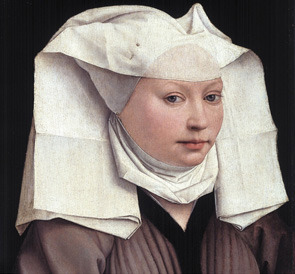Sandra Byrd's Blog, page 18
October 1, 2014
Website Re-launch Giveaway
I’ve redesigned my website to make it easier to navigate and to click on whichever blog post you’d like to further explore. Please, settle in for a few moments and enjoy yourself: visit my book pages, learn about having me coach you through the writing of your novel, or pick up some interesting historical tidbits or delectable recipes.
Need a new mug for autumn coffee or tea? I’m giving one away, in keeping with my love of all things Victoriana. (Mugs will be in washed wine color, not washed grey scale as below). Just leave a comment below and sign up for my e-newsletter (or let me know you’re already on it) and you’ll be entered. Winners drawn and notified in 30 days – so please leave an email address.
Thanks for stopping by! Didn’t win? Buy your own, here: SecondChanceCeramics Lots of great mugs to choose from.

September 29, 2014
Victorian Postcards
Last time I was in London I spent a lovely autumn morning sorting through antique stalls in Covent Garden. I invested in a treasure trove of Victorian era postcards and photos, and some of them came to influence, illustrate, or appear in the Daughters of Hampshire books. Have a look at a few!
 London Road, Southampton
London Road, Southampton
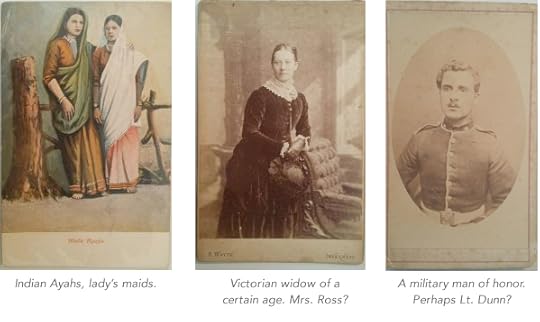
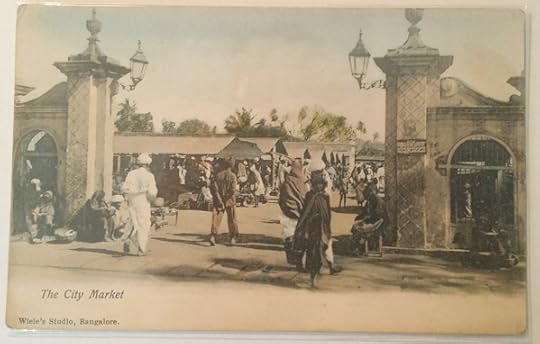 City Market, Bangalore
City Market, Bangalore
September 25, 2014
Karen Harper Endorsement, Mist
Karen Harper
NYTimes bestselling author of Mistress of Mourning
A marvelous mingling of mystery and deeply moving family ...
Karen Harper
NYTimes bestselling author of Mistress of Mourning
September 11, 2014
September 4, 2014
Mist of Midnight: Daughters of Hampshire, Book One
I am delighted to announce the launch of a new series: Daughters of Hampshire. There will be three books, Gothic romances all, which take place in Victorian England. Book 1, Mist of Midnight, will debut in March 2015. What do you think?! Please sign up for my mailing list, below, so I can let you know when the book is available and enter you into any contests run! I’ll be drawing five names from among the sign ups for a free advance copy of the book plus a Victorian lace book mark to be sent early next year.
Sandra’s newsletter sign up: Click Here
Mist of Midnight
In the first of a brand new series set in Victorian England, a young woman returns home from India after the death of her family to discover her identity and inheritance are challenged by the man who holds her future in his hands.
Rebecca Ravenshaw, daughter of missionaries, spent most of her life in India. Following the death of her family in the Indian Mutiny, Rebecca returns to claim her family estate in Hampshire, England. Upon her return, people are surprised to see her… and highly suspicious. Less than a year earlier, an imposter had arrived with an Indian servant and assumed not only Rebecca’s name, but her home and incomes.
That pretender died within months of her arrival; the servant fled to London as the young woman was hastily buried at midnight. The locals believe that perhaps she, Rebecca, is the real imposter. Her home and her father’s investments reverted to a distant relative, the darkly charming Captain Luke Whitfield, who quickly took over. Against her best intentions, Rebecca begins to fall in love with Luke, but she is forced to question his motives–does he love her or does he just want Headbourne House? If Luke is simply after the property, as everyone suspects, would she suffer a similar fate as the first “Rebecca”?
A captivating Gothic love story set against a backdrop of intrigue and danger, Mist of Midnight will leave you breathless.
August 27, 2014
Let Them Eat A Perfectly Divine Coconut Cake
“I’ve planned a special dessert. Something very American, but that will surprise both Patricia and Luc.” I told her the story behind it, about their disdain for cake mixes, and she laughed along with me.
I think, under different circumstances, we could have been friends.
I cut the dessert into pieces and plated them on the fine Belleek china my mother had unpacked from the new house just for this occasion. Marianne and I carried the plates into the living room and served dessert. We each took a small bite, watching Luc and Patricia for their reaction.
“Délicieux!” Margot proclaimed. “And I should know.”
“Is there a secret ingredient in this recipe?” Luc asked, eyes twinkling in a friendly manner. I think he was on to me.
“Mais oui,” I said. “But first, please tell me, do you like it?”
“You win,” Patricia said begrudgingly as she scraped the crumbs from her plate. Marianne and I laughed together, and when I shared the joke with the others, Luc laughed too, though Patricia and Margot barely smiled.
After dessert I cleared the dishes and left them quietly chattering, satisfied, I hoped, that they realized Americans weren’t complete culinary barbarians.
Let Them Eat a Perfectly Divine Coconut Cake
(with a Cake Mix!)
Ingredients:
One box butter recipe yellow cake mix
One small box coconut cream instant pudding
3 eggs
1 1/3 cup coconut milk (not coconut cream). You may have to emulsify this as it comes out of the can separated.
1/2 tsp coconut extract
1 stick of butter, softened
Frosting:
1 stick butter, softened
4 cups powdered sugar
1/8 cup milk or cream
1 tsp coconut extract
Shredded Coconut
Chopped Pecans (if desired)
Directions:
First, mix together the cake mix and the instant pudding till completely combined. Then add the 3 eggs, the coconut milk, the coconut extract, and the butter.
Blend for about 3 minutes in standing mixer or 5 minutes with handheld, in order to give the pudding time to develop.
Spread into two 8” round greased/floured cake pans. Light aluminum works better than dark or glass. Bake for 30 minutes at 350 until the cakes are just set and barely beginning to pull away from the pans. Don’t overbake till edges are brown or pulling away from pan. Let cool completely.
Whip the frosting ingredients together until completely fluffy. Frost the cooled cake, placing the first cake layer, round side down, on a plate, then spread frosting across the middle. Put the flat side of the other layer down on frosted center. Frost sides and top of cake.
Toast some coconut till golden brown (not dark brown) in the oven. Chopped pecans, too, if you prefer. Sprinkle on top of cake.
August 20, 2014
Elizabeth I’s Beloved Locket Ring
She held the realm’s finances in her grasp and the crown jewels round her neck or on her head, but there were only two pieces of jewelry that Queen Elizabeth I was reliably said to have never removed: her coronation ring, which she considered to be her “wedding” ring, and her ruby and pearl locket ring. This latter ring, shrouded in mystery, tells us as much about the queen’s heart as does the former.
The ring is generally referred to as the Chequers ring because its permanent home is now at the British Prime Minister’s country home, Chequers, and under the authority of its trustees. In 2008, Prime Minister Gordon Brown lent out several pieces of art from Chequers to the museum at country house Compton Verney. Kathleen Soriano, head of exhibitions at Compton Verney, said of the ring, “It’s a very moving piece because it’s so delicate and small and really evokes the sense of the story. It’s a very powerful object.”
Just what is that story evoked?
Most sources place the first appearance of the locket ring at 1575. Although some assert that the queen had it commissioned, there is no trail or definitive provenance for that claim. Traditionally, lockets are gifts. Inside might be a portrait of a lover or a child, or perhaps a lock of hair from someone who had passed on. The idea is to keep close to heart someone who is likely far removed by death or convention, politics, or sea. The idea, too, is to be able to shield or shroud the identity of the loved one by clasping and keeping the locket closed.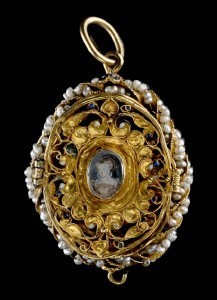
@ National Museums Scotland
English locket jewelers Lily & Will tell us that, “When Elizabeth I wore a locket ring … it marked a new beginning for the locket. It started to rise in popularity as Elizabeth I gave gifts of jewel encrusted lockets to many of her favourite loyal subjects—Sir Francis Drake being one of them.” The Scottish National Museum holds among its collection a locket with portraits of Mary, Queen of Scots and her son James, given to a trusted servant on the eve of her execution.
Then who is to be found inside of the ring so cherished by Queen Elizabeth? Another royal, executed mother, and her beloved only child. When opened, the Chequers ring reveals two portraits which face one another. One is clearly Queen Elizabeth, seemingly in her early forties, neatly fitting with the year 1575. The second portrait is widely understood to be her mother, Queen Anne Boleyn.
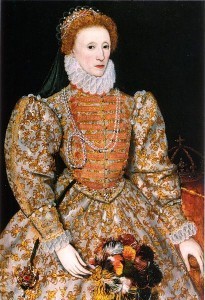
Because there is no direct provenance, there has been speculation that the portrait could be of the young Queen Elizabeth herself, or even of Queen Kateryn Parr, Elizabeth’s stepmother. It’s unlikely that the queen would have worn two portraits of herself throughout her life and in any case, there would have been no need for those portraits to be kept hidden. Although Elizabeth bore tender affection for Parr, the portrait within does not clearly resemble Parr, nor does the French hood worn by the subject fit in with the French hoods known to have been worn by Parr. It does, however, perfectly match the French hoods Anne Boleyn was well known for.
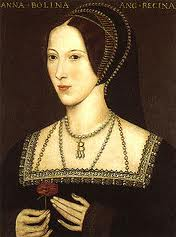 The British Museum says of Anne Boleyn: “Of the mid-sixteenth century representations of her, the most reliable must be the tiny miniature set into a ring of about 1575 which belonged to her daughter, queen Elizabeth I (The Chequers Trust; see ‘Elizabeth’ exhibition catalogue edited by Susan Doran, London, The National Maritime Museum, 2003, no.7). This likeness comes from the same source as the painting in the National Portrait Gallery.”
The British Museum says of Anne Boleyn: “Of the mid-sixteenth century representations of her, the most reliable must be the tiny miniature set into a ring of about 1575 which belonged to her daughter, queen Elizabeth I (The Chequers Trust; see ‘Elizabeth’ exhibition catalogue edited by Susan Doran, London, The National Maritime Museum, 2003, no.7). This likeness comes from the same source as the painting in the National Portrait Gallery.”vThe NPG portrait is widely understood to have been painted by John Hoskins the elder (c.1590-1664/5). Boleyn’s principle biographer Eric Ives believes that it is “more likely that Hoskins had access to an earlier image of the kind from which the NPG image originated.” In essence, perhaps there was one early portrait or sketch that both Hoskins and the painter of the locket miniature based their work upon.
Although Elizabeth likely could not remember what her mother looked like, there were those at her court old enough who would remember, and there were also those who still held quiet affections for and perhaps an illustration of Queen Anne. And just like that, the generosity of fiction allowed me to consider who might have loved and understood Elizabeth enough to risk giving her a ring with a portrait of her beloved, but taboo, mother inside.
Please leave a comment below to be entered into a drawing to win a Queen Elizabeth I Coronation notebook as well as a bar of the Queen’s Chocolate, the preferred chocolate for royal everyday divas!

August 12, 2014
A Seer, A Prophet or A Witch?
“And it shall come to pass in the last days, saith God, I will pour out of my Spirit upon all flesh: and your sons and your daughters shall prophesy, and your young men shall see visions, and your old men shall dream dreams…” Acts 2:17 King James Version
Six women in the Bible are expressly stated as possessing the title of prophetess: Miriam, Deborah, Huldah, Noahdiah and Isaiah’s wife. Philip is mentioned in Acts as having four daughters who prophesied which brings the number of known prophetesses to ten. There is no reason to believe that there weren’t thousands more, undocumented throughout history, then and now. According to religious tradition, women have often been powerful seers and that is why I’ve included them in my current novel: The Secret Keeper: A Novel of Kateryn Parr.
Hundreds of years before the renaissance, which would bring about improved education for women, Saint Hildegard of Bingen (1098-1179) wrote medicinal texts and composed music. She also oversaw the illumination of many manuscripts and wrote lengthy theological treatises. But what she is best known for, and was beatified for, were her visions.
Hildegard said that she first saw “The Shade of the Living Light” at the age of three, and by the age of five she began to understand that she was experiencing visions. [1] Although she was understandably reluctant to share her visions she continued to receive them, understanding them to be from God and, in her forties, was instructed by Him to write them down. She said, “I set my hand to the writing. While I was doing it, I sensed, as I mentioned before, the deep profundity of scriptural exposition… I spoke and wrote these things not by the invention of my heart or that of any other person, but as by the secret mysteries of God I heard and received them in the heavenly places. And again I heard a voice from Heaven saying to me, ‘Cry out therefore, and write thus!” [2]
Spiritual gifting is not given for the edification of the person receiving it, but for the church at large. Hildegard wrote three volumes of her mystical visions, and then exegeted them biblically herself. Her theology was not, as one might expect, shunned by the church establishment of the time, but instead Pope Eugenius III gave her work his approval and she was published in Paris in 1513.
Several centuries later, Julian of Norwich continued Hildegard’s tradition as a seer, a mystic, and a writer. In her early thirties, Julian had a series of visions which she claimed came from Jesus Christ. In them, she felt His deep love and had a desire to transmit that He desired to be known as a God of joy and compassion and not duty and judgment. Her book, Revelations of Divine Love, is said to be the first book written in the English language by a woman. [3] She was well known as a mystic and a spiritual director by both men and women. The message of love and joy that she delivered is still celebrated today; she has feast days in the Roman Catholic, Anglican, and Lutheran traditions.
Julian of Norwich
It had been for good cause that Hildegard and Julian kept their visions to themselves for a time. Visions were not widely accepted by society as a whole, and women in particular were often accused of witchcraft. This risk was perhaps an even stronger danger in sixteenth and seventeenth century England when “witch hunts” were common. While there is no doubt that there was a real and legitimate practice of witchcraft occurring in some places, the fear of it whipped up suspicion where no actual witchcraft was found. Henry the VIII, after imprisoning Anne Boleyn, proclaimed to his illegitimate son, among others, that they were all lucky to have escaped Anne’s witchcraft. The evidence? So obviously bewitching him away from his “good” judgment.In that century, the smallest sign, imagined or not, could be used to indict a “witch”. A gift handling herbs? Witchcraft. An unrestrained tongue? Witchcraft. Floating rather than sinking when placed in a body of water when accused of witchcraft and therefore tested? Guilty for sure. Women with “suspicious” spiritual gifts, including dreams and visions, had to be particularly careful. And yet they, like Hildegard and Julian before them, had been given just such a gift to share with others. And share they must.
Execution of Alleged Witches, 1587
One women in the court of Queen Kateryn Parr is strongly believed to have had a gift of prophecy. Her name was Anne Calthorpe, the Countess of Sussex. One source possibly hinting at such a gift can be found at Kathy Emerson’s terrific webpage of Tudor women: [4] Emerson says that Calthorpe, “was at court when Katherine Parr was queen and shared her evangelical beliefs. Along with other ladies at court, she was implicated in the heresy of Anne Askew. In 1549 she was examined by a commission “for errors in scripture” and that “the Privy Council imprisoned two men, Hartlepoole and Clarke, for “lewd prophesies and other slanderous matters” touching the king and the council. Hartlepoole’s wife and the countess of Sussex were jailed as “a lesson to beware of sorcery.”According to religious tradition women have often had very active prophetic gifts; we are mystical, engaging, and intuitive. I admire our sisters throughout history who actively, risk-takingly, used their intellectual and spiritual gifts with whatever power they had at hand.
[1] Bennett, Judith M. and Hollister, Warren C. Medieval Europe: A Short History (New York: McGraw-Hill, 2001), 317.
[2] Hildegard von Bingen, Scivias, trans. by Columba Hart and Jane Bishop with an Introduction by Barbara J. Newman, and Preface by Caroline Walker Bynum (New York: Paulist Press, 1990) 60–61.
[3] http://www.julianofnorwich.org/vision...
[4] http://www.kateemersonhistoricals.com...
July 23, 2014
Easy Coq au Vin
“I’m eager to try out some of the traditional French dishes I learned last year,” I said. “Is that okay?”
“Parisian Porterhouse?”
“No,” I said, shaking my head. He sounded like my dad. I wasn’t sure whether that was a good thing or not.
“How about the royalty of the beef world?” he tried again.
“What would that be?”
“Sir Loin.”
“Ha. How about coq au vin, chicken in wine?”
He drove into the parking lot. “Sounds good.” He was a good sport.
Easy Coq au Vin
Ingredients:
5 thick slices bacon, roughly chopped
4 chicken breasts, cut into 4 pieces each
8 ounces sliced cremini mushrooms
20 whole baby carrots, cut in half
3 cloves garlic, peeled and minced
2 large sweet onions, chopped
2 cups red or white wine
2 cups chicken broth
2 sprigs fresh thyme
Directions:
Cook the bacon in a large skillet until crisp. Transfer to a large plate but leave the bacon fat in the pan. Add the chicken to the pan and cook until it’s nicely browned all over, about 8 minutes total, stirring every couple of minutes. Transfer to the plate with the bacon. Sauté the mushrooms, carrots, garlic, and onions in the pan for 5 minutes. Pour the wine and broth into the pan and cook over high heat until it boils. Add thyme. Add the chicken and bacon, and simmer for 25 minutes. Remove thyme and serve. Serves 4.

